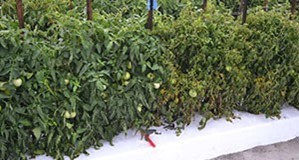Abstract
Bs2 tomatoes are transgenic tomatoes that have been engineered to contain the Bs2 gene from pepper. As such, they are considered a genetically modified (GM) food, or a genetically modified organism (GMO). Numerous trials conducted by University of Florida researchers have shown the benefits of these cultivars for bacterial spot disease management, and growers and industry members recognize the potential for Bs2 tomatoes to make Florida tomato production more sustainable. This 4-page fact sheet discusses the benefits that might be realized by the adoption of Bs2 tomato varieties, and the challenges standing in the way of their commercial production. Written by S. F. Hutton, J. W. Scott, J. B. Jones, R. E. Stall, G. E. Vallad, B. J. Staskawicz, and D. M. Horvath , and published by the UF Department of Horticultural Sciences, April 2015.
References
Ejeta, G. 2007. "Breeding for resistance in sorghum: exploitation of an intricate host-parasite biology." Crop Sci. 47:S216-S227. https://doi.org/10.2135/cropsci2007.04.0011IPBS
Flor, H.H. 1955. "Host-parasite interactions in flax rust-its genetics and other implications." Phytopathology 45:680-685.
Horvath, D.M., M.H. Pauly, S.F. Hutton, G.E. Vallad, J.W. Scott, J.B. Jones, R.E. Stall, D. Dahlbeck, B.J. Staskawicz, D. Tricoli, A.V. Deynze. 2015. "The pepper Bs2 gene confers effective field resistance to bacterial leaf spot and yield enhancement in Florida tomatoes." Acta Hortic. 1069:47-51. https://doi.org/10.17660/ActaHortic.2015.1069.5
Horvath, D.M., R.E. Stall, J.B. Jones, M.H. Pauly, G.E. Vallad, D. Dahlbeck, B.J. Staskawicz, and J.W. Scott. 2012. "Transgenic resistance confers effective field level control of bacterial spot disease in tomato." PLoS ONE 7(8):e42036. https://doi.org/10.1371/journal.pone.0042036
Hutton, S.F., J.W. Scott, W. Yang, S.C. Sim, D.M. Francis, and J.B. Jones. 2010. "Identification of QTL associated with resistance to bacterial spot race T4 in tomato." Theor. Appl. Genet. 121(7):1275-1287. https://doi.org/10.1007/s00122-010-1387-5
Kearney, B. and B.J. Staskawicz. 1990. "Widespread distribution and fitness contribution of Xanthomonas campestris pv. Vesicatoria avirulence gene avrBs2." Nature 346:385-386. https://doi.org/10.1038/346385a0
Kunwar, S., F. Iriarte, Q. Fan, E. Evaristo da Silva, L. Ritchie, N.S. Nguyen, J.H. Freeman, R.E. Stall, J.B. Jones, G.V. Minsavage, and J. Colee. 2018. "Transgenic expression of EFR and Bs2 genes for field management of bacterial wilt and bacterial spot of tomato." Phytopathology 108(12):1402-1411. https://doi.org/10.1094/PHYTO-12-17-0424-R
Li, L., Y. Zhu, S. Jin, and X. Zhang. 2014. "Pyramiding Bt genes for increasing resistance of cotton to two major lepidopteran pests: Spodoptera litura and Heliothis armigera." Acta Physiol. Plant 36:2717-2727. https://doi.org/10.1007/s11738-014-1642-5
Pernezny, K., and J. Collins. 1999. "A serious outbreak of race 6 of Xanthomonas campestris pv. Vesicatoria on pepper in southern Florida." Plant Dis. 83:79. https://doi.org/10.1094/PDIS.1999.83.1.79C
Potnis, N., G. Minsavage, J.K. Smith, J.C. Hurlbert, D. Norman, R. Rodrigues, R.E. Stall, and J.B. Jones. 2012. "Avirulence proteins AvrBs7 from Xanthomonas gardneri and AvrBs1.1 from Xanthomonas euvesicatoria contribute to a novel gene-for-gene interaction in pepper." Mol. Plant Microbe Interact. 25:307-320. https://doi.org/10.1094/MPMI-08-11-0205
Schneider, K.R., R.G. Schneider, and S. Richardson. 2002. Genetically Modified Food. FSHN02-2. Gainesville: University of Florida Institute of Food and Agricultural Sciences. https://edis.ifas.ufl.edu/fs084
Schultink, A., T. Qi, A. Lee, A.D. Steinbrenner, and B. Staskawicz. 2017. "Roq1 mediates recognition of the Xanthomonas and Pseudomonas effector proteins XopQ and HopQ1." The Plant J. 92(5):787-795. https://doi.org/10.1111/tpj.13715
Stall, R.E., J.B. Jones, and G.V. Minsavage. 2009. "Durability of resistance in tomato and pepper to Xanthomonads causing bacterial spot." Annu. Rev. Phytopathol. 47:265-284. https://doi.org/10.1146/annurev-phyto-080508-081752
Tai, T.H., D. Dahlbeck, E.T. Clark, P. Gajiwala, R. Pasion, M.C. Whalen, R.E. Stall, and B.J. Staskawicz. 1999. "Expression of the Bs2 pepper gene confers resistance to bacterial spot disease in tomato." Proc. Natl. Acad. Sci. USA 96:14153-14158. https://doi.org/10.1073/pnas.96.24.14153
Wichmann, G., D. Ritchie, C.S. Kousik, and J. Bergelson. 2005. "Reduced genetic variation occurs among genes of the highly clonal plant pathogen Xanthomonas axonopodis pv. Vesicatoria, including the effector gene avrBs2." Appl. Envir. Microb. 71:2418-2432. https://doi.org/10.1128/AEM.71.5.2418-2432.2005

